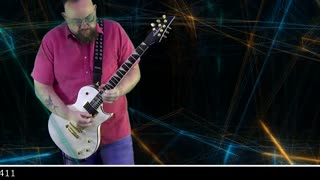Whipping Post Guitar Lesson | Duane Allman Solo Fillmore 1971 | Analysis by Gene Petty
Whipping Post Guitar Lesson on Duane Allmans Solo at the Fillmore East 1971
Intro
Duane Allman’s solo approaches 4 minutes as the first solo in the tune In it is a rich bounty of Duane's signature work.
Sextuplet 16ths
The opening is crafted with subtle rhythmic repetitions on each note. That is, one note will repeat a few times rapidly before moving to the next note. They are sixteenth note groups of 6 hence sextuplets in descension. There is a logic to how he walks the repetitions down the fret board. It doesn't shout out at you in your face, instead it invites you to tag along.
In the midst of this a pentatonic flourish grows out of the dorian opening.
New Material
About half a minute into it you hear the first bent string. This was not the standard cliché stretch that would start at the beginning of most solos like Sunshine of your love or Foxy lady. This was a subtly quiet stretch just to remind you of what potential lies ahead ; and its not done blatantly.
Now some more sextuplet repetitions as he changes to a higher register and breaks into a more pronounced stretching.
But its the stretching of the same note, and each time there's a different nuance that seems to grow like the opening of a flower in time lapse film. More sextuplet descension and he find a landing place down where he makes use of some open strings.
Landing Place
Almost at the end of the first minute he plays around with an E.Not just sitting on it but pulling off it, sustaining, pulling off in a teasing manner.
Then a smooth double string double pull off without making much noise about it. In other words it sound like he’s saying “hold on, we’re just resting here for a few seconds to get you ready for whats to come”.
Dorian Ascending Scale – Quarter Notes
Then seven strong quarter notes ascend in the A Dorian scale leading up to a very excitable country bend.
The country bend is a commonly heard riff, but in this context with fast minor chords sweeping underneath, we hear it in a completely new venue. Duane takes the country lick and wrings it out like a washcloth. A few more twists, playful turns and double stops bring us to the climax of the solo.
Climax
Its about one and a half minutes into the solo and he peaks with his famous triplet pull off lick at a clean rapid execution.
He drops back into a sextuplet descension and lifts us up with 8 or 9 stretch double stop unisons: he cant just bring us down hard. He needs to help us recover from the intensity of the climax riff.
Melodic Contrast
Approaching 2 minutes he slips into some new melodic material. The notes are longer and more seductive. Its not like a long successions of repetitions but a lyrical answer to all the fast and aggressive tones we just heard. Now he melts into a quiet repose as the band comes down to a hush. Some of the notes last 7 to 9 beats.
Once it comes down to a whisper, Duane starts biting into it again, gradually building up an edgy pentatonic syncopation.
It grows into a more legato time displacement against the steady rhythms. Then double stop flourishes take over still with a sense of expectation. This brings us to the triple stop tremolo.
Triple Stop Tremolo
The triple stops slide up and down the neck relentlessly, incessantly while his right hand performs a rapid tremolo.
The triple stop tremolo sounds like nothing before. Its texture is like liquid lightning and its sound reminds us that we are in a minor mode.
Restating the Country lick
Then the country lick again but this time with a cutting repetition. It seems like its going to build more but we are surprised with a simmering down. As if out of nowhere the whole tune becomes quiet again.
Repose
Now its like we are back in that repose of longer notes. And scale notes in syncopated long triplets. He has bought us down gradually and gentle almost in waves, rocking us back to the quiet place again.
Final Statement
This brings us to the final statement: it’s a quick little pull off riff. repeated four times with much space in between.
This is not a grandiose do-a-cartwheel-set-the-guitar-on-fire ending. Its Duane's genius in contemplation; he reminds us that all good things come to an end and he is gracefully handing back the lead to the singer.
He signals with the transition octaves that lead back to Greg's vocal.
Innovation
Just this solo in itself bought new life to rock in the 70’s. This was a sound that had no predecessors. Can anyone help me figure how this new sound was derived? I know he had Country and Blues influences but this is a far cry from country, and I cant trace much of this back to any blues lineage. He uses a cliché here and there but they all seem to sprout out of a new flower pot, from different soil. What makes him sound so authentic? How did he become so innovative in creating a new kind of soloing? These are questions I invite you to answer in the comments.
-
 20:59
20:59
Gene Petty
4 years ago $0.01 earnedWhipping Post Guitar Lesson | Dickey Betts Solo Fillmore 1971 | Gene Petty
84 -
 17:38
17:38
Gene Petty
4 years ago $0.06 earnedWhipping Post Guitar Lesson | A Dorian Mode | What To Play For Solos
2042 -
![Beatles Day Tripper Guitar Lesson [Riff Rhythm Solo]](https://hugh.cdn.rumble.cloud/s/s8/1/h/X/e/b/hXebc.0kob.6-small-Beatles-Day-Tripper-Guitar-.jpg) 22:14
22:14
PaluzziGuitar
2 years agoBeatles Day Tripper Guitar Lesson [Riff Rhythm Solo]
4122 -
![Blues Riffs Guitar Lesson for Beginners [How to Solo with Rhythm]](https://hugh.cdn.rumble.cloud/s/s8/1/k/i/5/g/ki5ge.0kob.1-small-Blues-Riffs-Guitar-Lesson-f.jpg) 27:48
27:48
PaluzziGuitar
2 years agoBlues Riffs Guitar Lesson for Beginners [How to Solo with Rhythm]
573 -
![Major Scale Soloing Guitar Lessons for Beginners [How to Play Riffs]](https://hugh.cdn.rumble.cloud/s/s8/1/F/R/R/G/FRRGb.0kob.3-small-Major-Scale-Guitar-Lessons-.jpg) 19:40
19:40
PaluzziGuitar
3 years agoMajor Scale Soloing Guitar Lessons for Beginners [How to Play Riffs]
147 -
![Blues Riffs Guitar Lesson for Beginners [How to Solo In Any Key]](https://hugh.cdn.rumble.cloud/s/s8/1/i/I/j/f/iIjfe.0kob.1-small-How-to-Solo-In-Any-Key-Guit.jpg) 18:41
18:41
PaluzziGuitar
2 years agoBlues Riffs Guitar Lesson for Beginners [How to Solo In Any Key]
301 -
![Blues Soloing Guitar Lessons for Beginners [Open E Riffs]](https://hugh.cdn.rumble.cloud/s/s8/1/n/P/2/h/nP2hc.0kob-small-Blues-Soloing-Guitar-Lesson.jpg) 6:42
6:42
PaluzziGuitar
2 years agoBlues Soloing Guitar Lessons for Beginners [Open E Riffs]
663 -
 3:20
3:20
DanH411 Guitar Instrumentals and Guitar Lessons
5 months agoWhat Can the Morgan Wallen Song "Last Night" Teach You About Guitar Solos? Part 1 #guitarlessons
4 -
![Country Blues Guitar Lesson for Beginners [Pentatonic Major Scale Riffs]](https://hugh.cdn.rumble.cloud/s/s8/1/t/X/r/E/tXrEb.0kob.5-small-Country-Blues-Guitar-Lesson.jpg) 16:59
16:59
PaluzziGuitar
3 years agoCountry Blues Guitar Lesson for Beginners [Pentatonic Major Scale Riffs]
3101 -
![America A Horse With No Name Guitar Lesson [Rhythm Strum Solo]](https://hugh.cdn.rumble.cloud/s/s8/1/F/o/P/e/FoPec.0kob.8-small-America-A-Horse-With-No-Nam.jpg) 22:08
22:08
PaluzziGuitar
2 years agoAmerica A Horse With No Name Guitar Lesson [Rhythm Strum Solo]
731